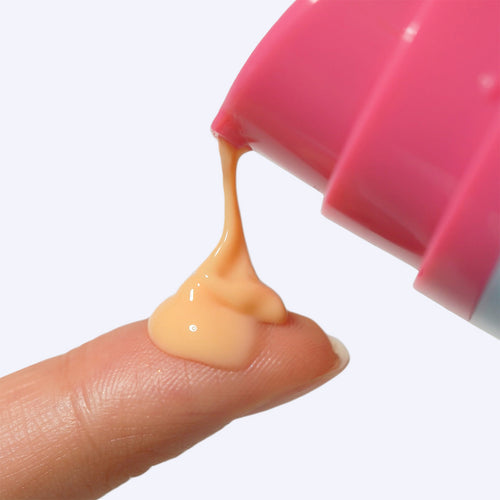What’s INN
Hover to learn more
Click to learn more

Hover to learn more
Click to learn more
What’s Inn
Our products help with these main concerns.

Hover to learn more
Click to learn more
What’s Out
Our products are free from:
Here's a list of our favorite skincare
ingredients that deliver visible results.
Both Tetrahexyldecyl Ascorbate (THD) and 3-O Ethyl Ascorbic Acid are highly stable oil soluble forms of Vitamin C. Because they are oil soluble and the skin's surface contains lipids and oils they have been shown to be 50x more effective at penetrating skin than water soluble forms like L-Ascorbic Acid. THD & 3-O Ethyl Ascorbic Acid also have a similar pH to skin (slightly acidic) they can cause less irritation than their water soluble cousins which require a low acidic pH (around a 3.5) to remain stable and effective.
Research shows that Vitamin C provides antioxidant protection from free radicals and helps to visibly reduce hyperpigmentation & brighten skin tone while visibly reducing wrinkles & sagging skin. Oil soluble forms of Vitamin C like THD & 3-O E pair well with ingredients like retinol which shares a similar pH. Together they can be part of a powerhouse skincare routine.
Retinol is a type of retinoid that is one of the most widely studied skincare ingredients. It is shown to help smooth skin texture, reduce hyperpigmentation, sun damage & acne scars while helping to clear acne and visibly reduce wrinkles and skin sagging. It is an ingredient that almost everyone can benefit from adding to their routine.
Retinol works to speed cell turnover, but has also beens hown to travel to a deeper level within the skin reaching the basal layer of the epidermis and sometimes small amounts reach the dermis.
There it has been shown to help boost collagen & elastin production helping to keep skin visibly plump & firm. Retinol requires two conversions to become retinoic acid which is bioavailable to the skin.
Other forms of retinoids include Retinal, which requires only 1 conversion but can be irritating to the skin and Retinoic Acid Ester which requires 3 conversions and is the most gentle of the retinoids.
Retinoids can make you more sensitive to the sun so always use a broad spectrum SPF during the day.
Peptides are the amino acids or building blocks of proteins needed by the skin like collagen, elastin, and keratin.
They are essential for healthy skin & hair. Collagen itself is made up of polypeptide chains, but collagen molecules are often too large to penetrate skin topically.
Peptides have a smaller molecular size allowing them to penetrate more effectively. Different peptides have different topical benefits.
Some have been shown to help boost collagen & elastin production for visibly firmer, smoother skin with a visible reduction in wrinkles.
Other peptides have amazing anti-inflammatory properties and help to visibly soothe skin.
Ceramides are fats or lipids found within the skin. Skin is generally composed of around 50% ceramides.
Ceramides essentially act as the glue that holds our skin cells together keeping the skin barrier healthy and intact.
A healthy skin barrier keeps hydration in while keeping pollution and bacteria out. Several factors can deplete ceramides including age, pollution, sun damage, and skin conditions like eczema & psoriasis.
Research has shown that topically applying ceramides can help improve skin’s natural moisture barrier.
Squalane is a stable form of squalene that is used in topical applications for skin and hair. It is often derived from olive or sugarcane.
It can also be harvested from shark liver so be sure to look for vegan squalane in your products. Squalene is a lipid naturally produced by skin cells and found in our sebum.
As we age our levels of natural squalene decline leaving skin drier and rougher.
By applying topical squalane which is biocompatible with skin, you can improve hydration for visibly smoother, softer skin. Squalane also has excellent antioxidant properties to protect skin from free radicals that can lead to premature aging.
Aka Alpha Hydroxy Acids. AHAs are water soluble exfoliating acids (also known as chemical exfoliants) that help to break up the bond between dead skin cells in the epidermis. The rate of desquamation, or rate at which we shed dead skin cells increases as we age leading to a visibly thicker, duller, rougher outer layer of skin.
AHAs can help speed up the shedding of these dead skin cells revealing younger, brighter, smoother, healthier looking skin. Some of the most well studied and well known acids include glycolic, which has the smallest molecular weight and can travel deeper and lactic which has a larger molecular weight than glycolic making it more suitable to sensitive skin types. Some others include malic, tartaric, and mandelic.
AHAs can make you more sensitive to the sun so always use a broad spectrum SPF during the day.
AKA Beta Hydroxy Acid. BHAs are oil soluble exfoliating acids. Because BHAs are oil soluble they are the only acids that are able to penetrate skin’s natural lipids and oils allowing it to get into the pore to exfoliate & de-gunk. Salicylic Acid is the most common BHA and is often used in the treatment of acne and blackheads.
SA is also anti-inflammatory and is generally tolerated by all skin types including sensitive, making it a great option for those who are sensitive but oily or acne-prone.
Hyaluronic Acid is a humectant that has the ability to hold up to 1000 times its weight in water. When applied topically it draws moisture into the skin from surrounding environments.
If you live in a dry climate or have dry skin it is very important to layer a moisturizer over your hyaluronic acid to ensure the moisture stays locked in your skin where you need it most. When applied topically.
Hyaluronic Acid visibly plumps skin with hydration for a bouncy glowing complexion.
Tranexamic Acid is derived from the amino acid Lysine. When topically applied, research has shown that it interrupts pathways for melanin production that lead to dark spots, hyperpigmentation and melasma.
Tranexamic acid is typically good for all skin types and research has shown it can visibly improve rosacea.
Niacinamide is a form of Vitamin B-3. It is a wonderful topical ingredient with a lot of different benefits. Research shows that when topically applied it visibly improves hyperpigmentation and redness for a brighter more even-toned complexion.
It has also been shown to strengthen skin’s natural moisture barrier while providing antioxidant protection for smoother looking skin. In addition, some research has shown that it helps to balance oil and sebum production.
Bakuchiol is a plant-based retinol alternative. It is not the same thing as a retinoid and does not act the same way within skin, but research has shown it to have similar benefits to retinol without the irritation. Bakuchiol is extracted from the leaves and seeds of the Babchi plant. It is generally considered to be safe for all skin types and helps to visibly reduce wrinkles, clarify, smooth and brighten the appearance of skin. Bakuchiol doesn’t sensitize skin to the sun like retinoids can so it is safe to use during the day.
Here's what's out, so you have one
less thing to worry about.
